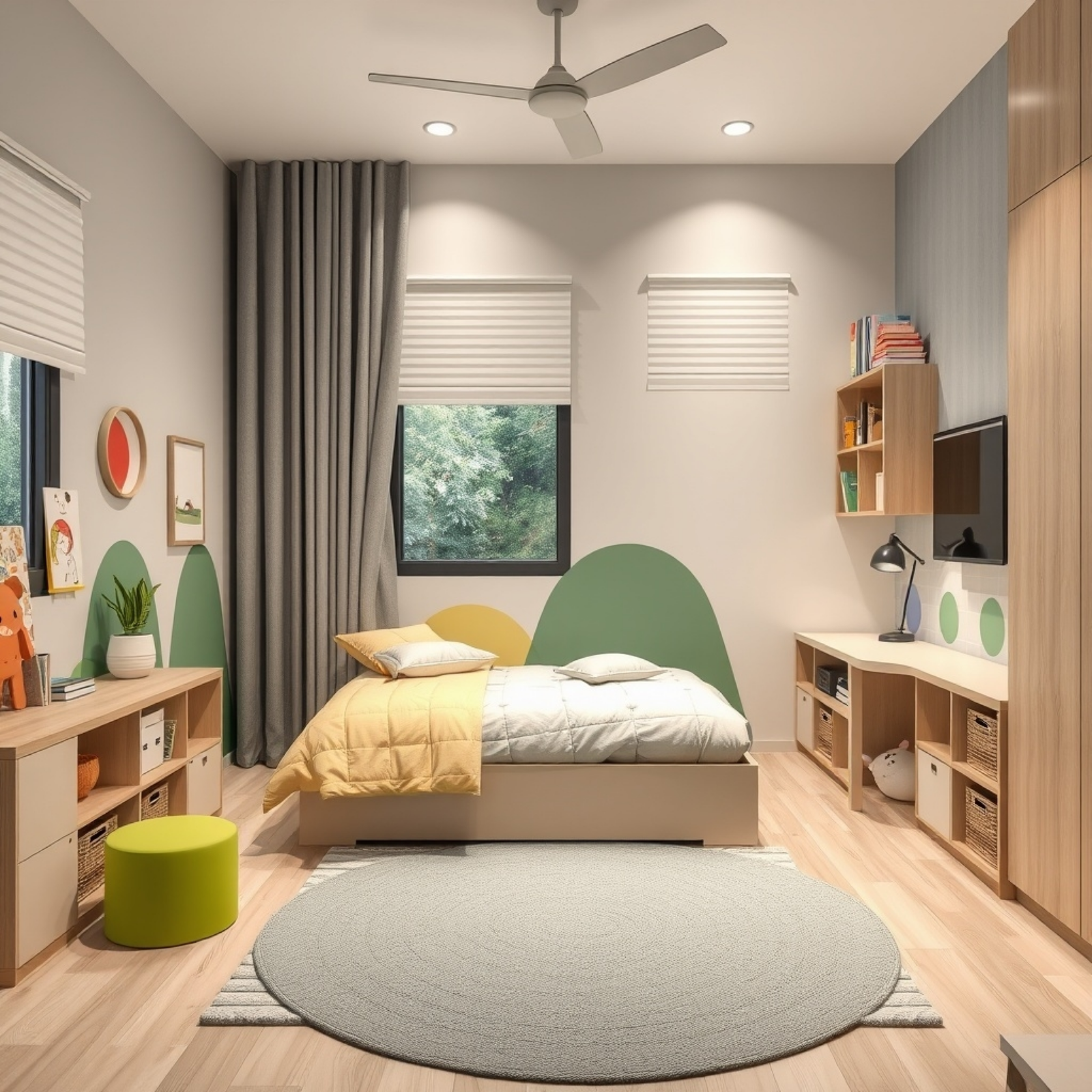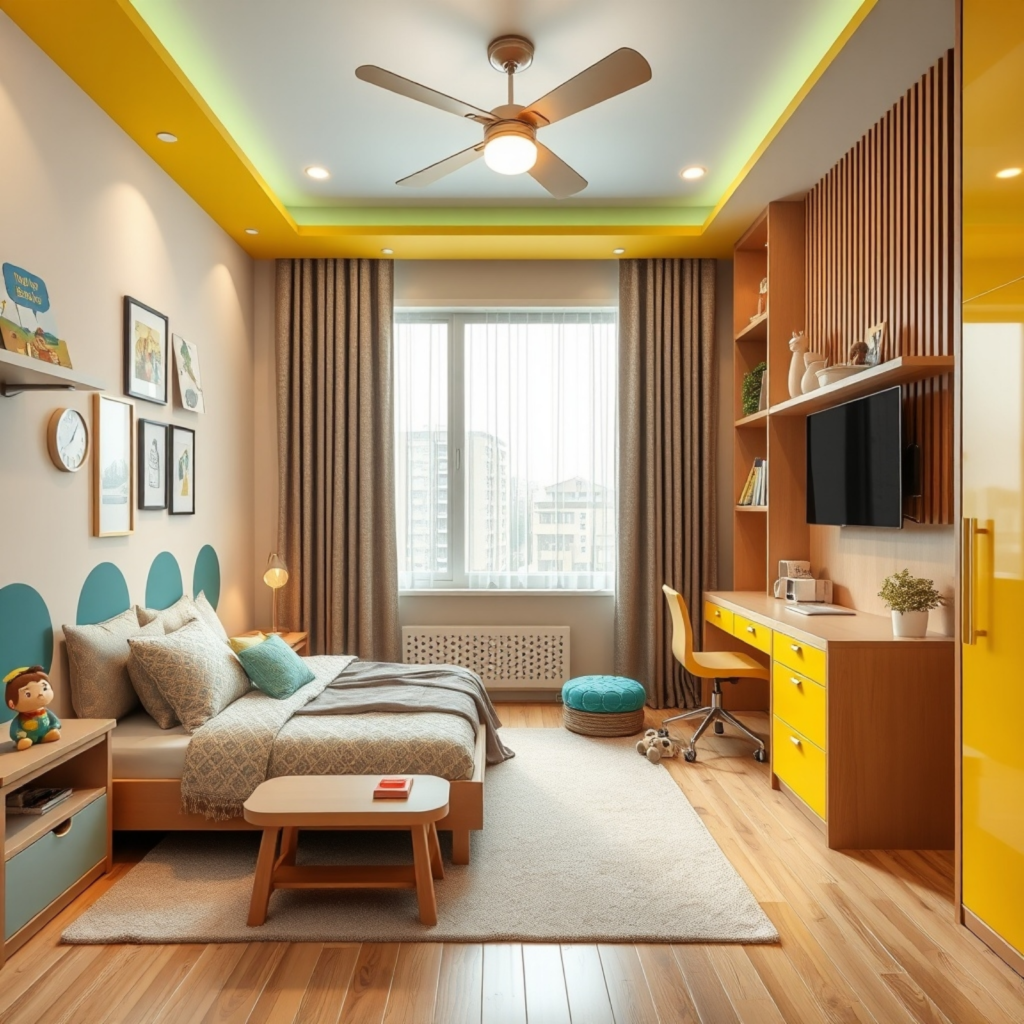

Designing a child’s bedroom is an exciting endeavor that combines creativity with functionality. A well-designed bedroom should inspire creativity, offer comfort, and accommodate the changing needs of a growing child.
The images provided display a collection of modern and vibrant designs that cater to various aesthetics, focusing on using color, lighting, and spatial arrangements to create a warm and engaging environment. This article will delve into each design, providing in-depth insights and tips for architects and homeowners looking to transform children’s bedrooms into imaginative spaces.
1. Incorporating Playfulness with Colors and Geometry
The first design features a lively space where a combination of teal, yellow, and natural wood elements is used to create a bright, cheerful environment. The design uses accent walls and playful geometric patterns to establish a fun atmosphere.
Architects and designers should consider using vibrant colors that are stimulating yet soothing, ensuring that the space is dynamic but not overwhelming. The built-in storage units, open shelves, and integrated study desks also serve as functional elements that keep the room organized and clutter-free.
Tip: Utilize a combination of bold and neutral colors to define different areas within the room, such as the study zone, play area, and sleeping nook. Adding geometric shapes and creative shelving can elevate the visual interest of the room.
2. Blending Patterns and Textures for a Cozy Look
The second room showcases a sophisticated use of floral patterns and muted blue tones. This design is ideal for those who prefer a more traditional yet contemporary aesthetic.
The curtains, bedding, and wall colors blend seamlessly, creating a cozy and inviting ambiance. Architects can incorporate these elements by mixing textures and patterns to add layers and depth to the design.
Tip: Use patterned textiles like cushions, curtains, and rugs to infuse character into the room. Combine with wooden furniture and soft lighting to enhance the overall warmth.

3. Minimalistic Approach with a Touch of Nature
This design focuses on simplicity and nature-inspired elements, using soft greens and yellows to bring a sense of calmness to the space.
The minimalistic furniture and organic shapes on the walls reflect a modern take on children’s rooms that prioritize serenity and space for imagination. The large windows let in plenty of natural light, making the room feel spacious and airy.
Tip: Keep the design minimalistic by opting for multifunctional furniture and subtle color palettes. Use natural materials like wood and fabrics in earthy tones to maintain a balanced look.

4. Vibrant Spaces with Multi-functional Zones
The final design combines bold yellows with blue and natural wooden textures, creating a vibrant space that feels lively and energetic.
This layout is designed with separate zones for sleeping, studying, and playing, which is ideal for older children who need more structured spaces. The use of a ceiling fan, layered lighting, and organized storage ensures the room is comfortable and efficient.
Tip: Zoning is key in children’s bedroom designs. Use different colors, lighting, and furniture placement to establish distinct areas within the room. This not only makes the space more functional but also helps children associate each area with a specific activity.

More Latest Post :
- Islamic Futuristic Architecture: Blending Tradition with Modernity for Sustainable Cities
- Futuristic Architecture and Eco-City Innovations: Design Ideas and Tips for Architects
- Elevate Your Space with Modern Egg Chair Designs
- Modern Homes and Interior Design Tips: A Guide for Homeowners and Designers
- Modern Home Architecture: Design Tips for Builders, Architects, and Investors
